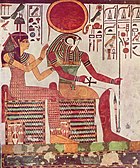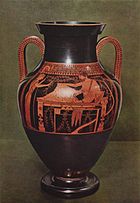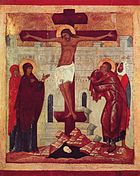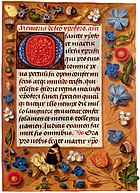Western Painting: Egypt, Greece and ancient Rome, Renaissance and Mannerism
Western Painting
Egypt, Greece and ancient Rome

Representation of Nefertari in the tomb of Ramses II (XIII century BC.
If the ancient Egypt is a civilization with a great tradition in matters of architecture and sculpture, she has also developed the art of mural painting in the temples and buildings as well as the illustration of manuscripts on papyrus. The mural and decorative painting is typically Egyptian graphic, sometimes more symbolic than realistic. The Egyptian painting is characterized by figures whose contours are very apparent (as in the comic-strip), with silhouettes flat, where the symmetry is a constant feature. Egyptian painting is closely related to the written language that are called hieroglyphs. The Egyptians also made paintings on canvas which few examples have been preserved until today.
Bull frieze in the Palace of Knossos
North of the Egypt, in Crete, the Minoan civilization has also developed the art of mural painting, as in the palace of Knossos. The paintings resemble those of Egypt but with a much freer style. Around 1100 BC. BC, the tribes of the north of Greece conquered Greece and the Greek art took a new direction.

Painting Greek amphora representing Heracles made by the painter Andokides, 520 av. AD
The ancient Greeks knew of the great painters, great sculptors and great architects. The Parthenon is an example of this architecture. The sculpture Greek marble is often described as the classical art form of the most developed. The painting on ceramic pottery and ancient Greek offers a particularly instructive of the way society in Ancient Greece functioned. The style of painting faces black and red figures is a good example of what Greek painting. The ancient texts mention a few famous Greek painters as Apelles or Zeuxis, specialists in painting on wood panels which no example has survived and unfortunately we know only through the descriptions in contemporary Roman texts. It is generally accepted that Zeuxis, who has lived in the fifth and sixth century BC. AD is the first to use the sfumato. According to Pliny the Elder, the realism of the paintings of Zeuxis was such that the birds have tried to eat the grapes he had painted. Apelles is described as the greatest painter of the ancient world because of his perfect mastery of the art design and bright colors.

Initiation Ritual, 60 av. AD
The Roman art was influenced by Greece and, somehow, we can consider that it is the descendant of ancient Greek painting. However, Roman painting has unique characteristics. The only Roman paintings that have survived time are murals, most villas in Campania in the south of the Italy. Roman painting can be grouped into four categories according to its style or period by which it was conducted It contains the first examples of trompe-l'oeil, pseudo-perspective scenery and pure Among the very few paintings of portraits that have survived were found a large number of portraits of Fayoum dating from the Late Antiquity. Although these paintings are probably not of the highest quality, they give an idea of the quality and subtlety of ancient painting.
Middle Ages

Crucifixion, Byzantine, XIV century
The advent of Christianity was accompanied by a change of mindset that influenced the styles of painting. In the sixth century, the Byzantine art has focused on the iconography of traditional, influenced by the painting of icons, Greek and Russian Orthodox, and it has changed relatively little over a thousand years of the Byzantine Empire. There were also many wall paintings and frescoes, but few of them survived unlike mosaics byzantine. In general, the art of Byzantium was based on abstraction and stylization of figures and landscape. However, there were periods, particularly in X century with the Macedonian art, where the Byzantine art became more flexible in its approach.

excerpt from Book of Hours
In Europe, the Middle Ages, the first form of art and painting to emerge was the Anglo-Saxon art whose only surviving examples are illuminated manuscripts like the Book of Kells. They are famous for their abstract decoration, although sometimes portraits and scenes are also depicted, especially portraits of evangelist. The Carolingian art and of Ottoman also left manuscripts, although some murals remain. At this time, the paint blends influences island and "barbaric" and a strong Byzantine influence.
The walls of churches Romanesque and Gothic were decorated with paintings or sculptures. The few remaining walls are of great intensity and combine the decorative energy of the Celtic art with a new treatment of the characters.

Detail of a fresco by Giotto di Bondone (1304-1306)
The paint on wood panels spread to the Romanesque period, under the influence of Byzantine icon painting. Towards the middle of the thirteenth century, the medieval art and Gothic painting became more realistic, with a beginning interest in the representation of volume and perspective in Italy with Cimabue and his pupil Giotto di Bondone. With Giotto, the treatment of composition by the best painters became more open and innovative. Giotto and Cimabue are considered the two great masters of medieval painting in Western culture. Cimabue, in the Byzantine tradition, had a more realistic and dramatic sound art, while Giotto developed these innovations to a higher level which moreover laid the foundations of Western classical painting. The two artists were the vanguard of naturalism.
The churches were built with more windows and the use of stained glass was spread as a means of decoration. One of the most famous is the cathedral of Notre-Dame de Paris. In XIV century, Western societies were richer and more cultivated and painters found new opportunities with the nobility and the bourgeoisie. The illuminations have taken a new character, the women of the court, dressed in fashion, were represented in their environment. This style quickly became an international model and panel paintings in tempera and the altarpieces gained importance.
Renaissance and Mannerism

The Triumph of Galatea by Raphael (1512-1514)

God creates Adam by Michelangelo
The Renaissance is often considered the golden age of painting spanning the fourteenth to seventeenth century. In Italy artists like Paolo Uccello, Fra Angelico, Masaccio, Piero della Francesca, Andrea Mantegna, Filippo Lippi, Giorgione, Tintoretto, Sandro Botticelli, Leonardo da Vinci, Michelangelo, Raphael, Giovanni Bellini and Titian painting dealt at its highest level by the use of perspective, the study of human anatomy and proportion, and an unprecedented improvement in painting techniques.
The Flemish painters, the Netherlands and German Renaissance such as Hans Holbein the Younger, Albrecht Dürer, Lucas Cranach, Matthias Grünewald, Hieronymous Bosch and Pieter Bruegel the Elder had a different approach from their Italian colleagues, more realistic and less idealized. The adoption of oil painting whose invention was traditionally, but wrongly, attributed to Jan van Eyck, has made possible a painting facilitating the representation of reality. Unlike the Italians, whose work was strongly influenced by the art of Greece and ancient Rome, the painters were impregnated Northern style of sculpture and illuminated manuscripts of the Middle Ages.

Portrait of Thomas More by Hans Holbein the Younger (1527)
The Renaissance painting reflects the revolution of ideas and science (astronomy, geography), the Protestant Reformation and the invention of the printing. Albrecht Dürer, who is considered one of the largest printers, indicated that painters were not only artisans but also thinkers. With the development of the painting easel during the Renaissance, the painting has gained independence from architecture. Artists not only represented more religious and traditional images, but they have their paintings included in representations of the world around them, or images produced their own imaginations.

Painting from El Greco
In the fifteenth and sixteenth centuries, panel paintings, which could be hung on the walls and be moved at will, have become increasingly popular for both churches and private homes. These paintings are more mobile gradually supplanted the mural or fresco that is integrated with a permanent structure, such as altarpieces. The High Renaissance had seen a stylized art known to mannerism. Instead of balanced compositions and rational approach to the perspective that characterized art at the dawn of the sixteenth century, the Mannerist looking instability, artifice, and doubt. The faces and gestures frozen paintings by Piero della Francesca and the calm Virgins of Raphael are replaced by expressions of concern Pontormo and the emotional intensity of El Greco.
Like it on Facebook, Tweet it or share this article on other bookmarking websites.


